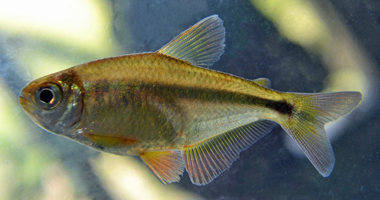new species:
Astyanax puka Mirande, Aguilera & Azpelicueta, 2007
type locality:
Argentina, Tucumán, Monteros, Río Salí basin, Río Mandolo, under the bridge of Ruta Provincial 344, near Monteros City; holotype CI-FML 3844, paratypes CI-FML 3849 (19)
further distribution in Argentina:
Tucumán, Trancas, Río Salí basin, Río Salí at Balneario El Boyero; paratypes CI-FML 3851 (2)
published in:
Mirande, J.M., G. Aguilera & M. Azpelicueta (2007):
A new species of Astyanax (Characiformes: Characidae) from the endorheic Río Salí basin, Tucumán, northwestern Argentina.
Zootaxa 1646: 31-39
abstract (from publication):
Astyanax puka, new species from the endorheic Río Salí basin, is diagnosed by the following combination of characters: shallow body (33.5–39.8 % SL), 36–38 perforated scales in lateral line, 6/5 transverse scales, 9–10 gradually decreasing dentary teeth, distally expanded premaxillary teeth, one distally expanded maxillary tooth with 7–9 cusps, short upper jaw length (34.5–37.8 % HL), short maxilla (20.7–23.3 % HL) expanded abruptly under maxillary tooth position, short postorbital distance (36.6–46.9 % HL), short distance between pelvic and anal-fin origins (17.1–20.6 % SL), 22–27 branched anal-fin rays, long caudal peduncle (13.3–16.5 % SL), bony hooks restricted to pelvic-fin rays 2 to 6 and anterior 6–13 branched anal-fin rays on mature males, and the presence of broad denticles on anterior, lateral, and posterior edges of first ceratobranchial gill rakers.


